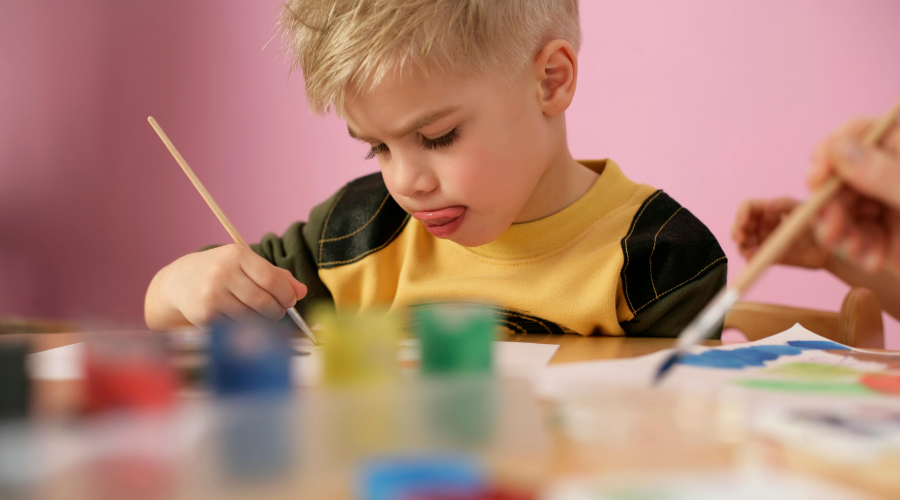settings
children
With Famly since
Looking to rejuvenate your classroom decor?
As educators, we want to make sure we are creating a safe, supportive classroom environment that promotes learning and emotional and social development. Your classroom decorations and displays should do the same. That's why we created this guide on how to ensure your classroom decor is filled with child-led displays that reflect their learning process and development journey.
Later on, we’ll talk about the Learning Journey Display Approach, which is one way to create classroom decorations and displays that are truly child-led.
But first, why does it matter that we make early years displays child-led? And where do educators often go wrong?
Preschool classroom decor & themes: What are common mistakes?
It’s easy to get too caught up in using decorations that are finished, final, and pristine.
But, one of the biggest challenges is getting your educators to understand that their displays aren’t really a reflection of them. Or at least, not in the way some of them might think.

Bulletin boards, walls, doors - and any other classroom decor - doesn’t need to look perfect, or show off something to other educators, parents and caregivers.
When we focus on how other adults will perceive our classroom, we often have:
- Themes and decor that stay up for months.
- Beautiful, extravagant borders and filler that take away attention from the children’s work.
- Reproduced activities that show no real ownership or creativity.
- Information for parents or practitioners within the play environment that children can’t decipher.
You put the child first in everything else when it comes to the environment, so why not have child-created decor too?
What makes a good interior for a classroom?
The best interior and classroom decor for preschools are child-led.
Classroom decor and themes should not reflect an endpoint, but instead should showcase the children’s learning process and journey.
The big ideas

When done right, displays can actually help educators deliver child-led learning.
Here are just some of the benefits of involving children more heavily in the display-making process:
- Children are more likely to engage with and reflect on the work they created themselves.
- It can help them to become self-aware and self-confident learners.
- They are actively engaging with the process of their learning.
- It gives them increased ownership of their environment.
- It lets them take pride in the work they’ve created.
- Knowing it’s temporary, they may feel more confident to push the boundaries of what they create.
- It gives them a chance to recall and revisit their work and learning.

Classroom decoration ideas for preschool
Rather than listing off different themes and decoration ideas, here are some questions to help you feel inspired and decide what's best for your classroom.
First and foremost, just ask yourself one question: “Why?” Why are you choosing to make this a display? Why are you choosing to hang this on your classroom wall?
If you want to improve your learning environment’s decor, here are three ways to get you started:
1. Content
Here are some questions to consider the type of work and content you're putting in your displays.
Questions
- Who is the decor for?
- How much of what’s on the walls is made by the children?
- Who decides what is on the walls?
- How old is the decor?
- Do adults talk with children about the wall decorations?
- Does the decor seem creative and varied, or reproduced and similar?
- Can I include the child’s voice more?
- Are they too focused on an outcome or is there a focus on the journey?
2. Location
To be truly child-centred, classroom decor has to be accessible to the children. That means getting on the floor and seeing what they look like from a child’s perspective.
Questions
- Why do I have the decor where they are on the wall?
- How do I want children to interact with the wall decor?
- When sitting on the floor, can the children see the decor?
- Can I add decorations and themes to the outdoors too?
- Would a child want to sit near and reflect on what is on the wall?
3. Design
One of the biggest conversations happening in the early years for some time has been about bright colored backgrounds vs a more neutral approach. While the former can often be more fun and engaging, research suggests that busy bright displays can distract and overstimulate children.
Questions
- Why have I chosen that background? And who for?
- How has a change in decor or theme affected child behavior?
- Can children properly see and recognize everything on display?
- Is the decor inviting and engaging?
- What stands out to me about the decor from child-level?
- Do my SEN children move away or become stressed when near the display?

The Learning Journey Display Approach
In addition to the three themes mentioned above, The Learning Journey Display Approach is all about having displays and decorations that celebrate individuality and reflects the journey, not the destination.
1. Give each child a section
Start with a long, low section of wall that the children can all easily see and interact with.
Next, choose your preferred backing, considering colours, overstimulation and everything we talked about above. Use borders to divide it into equal sections, giving each child a section of their own.
The idea is to give each child ownership of their section of the display, turning them into active participants, not passive observers.
2. Start with some photos
Each section should begin with a photo of the child, and then ask them to bring in photos of their family, carers, friends, pets – the people important to them.
This makes it feel familiar and inviting, while promoting a sense of self-awareness.
3. Show children what you’ve done before
With the start of a new year or when new children join, sit down with them and show them what children have done with their sections before.
Show them photographs of what other children have added or talk to them about what they might like to add, so that they have some ideas and know it’s their choice.

4. Put up stuff
Maintain a conversation with the children about what they want to put up. Explain to them that things can go on, and come down, so they challenge themselves with what they want to display.
You can add photographs of play, activities, or creations. You want the child to take the lead with what goes up. Once new things go up, you can keep the old notes, photos, messages and work in a folder.
5. Add the child’s voice
This is where you can work with the child to add context around the work. Speech bubbles about what they said. Short texts about the child’s interests. Detail the words and language they were using while their play was going on.
It’s important that the child is a part of this process, so sit down and write these speech bubbles with them, so they know you’re using their words.
Respect the process with child-created classroom decor
This is by no means the only way you can have displays that contain the child’s voice and their interests in your setting. But hopefully it might inspire you to rethink the way you approach displays, and come up with your own interpretation that works for you and your classroom or center.
It can feel scary to move away from finished, polished wall display, but once you get into the swing of things, you’ll see how this approach to display and decor can increase children’s confidence and pride in their learning journey and classroom environment.
And it saves you more time!
Encouraging more child-led displays gives you, the educator, more meaningful time with the children and decreases the hours you spend creating displays.
Further Reading
- Creating Child-Led Wall Displays by Kristine Beeley – This Teach Early Years piece has lots of great information about why displays should be child-led and how to involve the children in the process.
- Early Years Display by Alistair Bryce-Clegg – If you want to explore this topic further, this book by Mr B-C gives specific examples, and covers how to do a display when budgets or space is tight, as well as how to take displays outside too.
Free downloadable Early Childhood resources
Explore our library of longer-form books, guides and editable templates - all free to download.
Explore free resources







